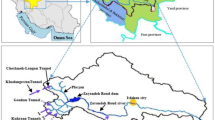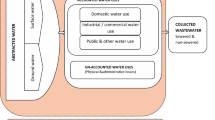Abstract
The water footprint is an indicator of freshwater consumption that looks not only at direct water consumption of a consumer or producer, also at the indirect water consumption. The water footprint can be regarded as a comprehensive indicator of freshwater resources appropriation, next to the traditional and restricted measure of water withdrawal. Based on the concept and calculating method of water footprint, this paper estimates the water footprint of China in 2007. The result shows that the total water footprint of China is 856.34 × 109 m3 and the per capita water footprint is 648.11 m3/year. The spatial difference of per capita water footprint is obvious among all provinces of China. Generally, the more developed cities, the southern and coastal provinces have a higher per capita water footprint, lower water footprint intensity and higher efficiency of water consumption, while the North West China has lower water utilization efficiency. China is one of the thirteen water scarce countries in the world and spatial distribution of water resources is non-uniform. In addition to the virtual water trade, government should apply advanced technology and best available management practices, improve the efficiency of water use, reduce virtual water content per unit product, and continue nation-wide readjustment of industrial structure to guarantee an efficient use of limited water resources.
Similar content being viewed by others
References
Alaa E-S (2010) Virtual water trade as a solution for water scarcity in Egypt. Water Resour Manage 24:2437–2448
Allan JA (1993) Fortunately there are substitutes for water otherwise our hydro-political futures would be impossible. In: Priorities for water resources allocation and management. ODA, London, pp 13–26
Allan JA (1994) Overall perspectives on countries and regions. In: Rogers P, Lydon P (eds) Water in the Arab World: perspectives and prognoses. Harvard University Press, Cambridge, pp 65–100
Brown S, Schreier H, Lavkulich LM (2009) Incorporating virtual water into water management: A British Columbia example. Water Resour Manage 23:2681–2696
Bruinsma J (ed) (2003) World agriculture: towards 2015/2030: An FAO perspective. Earthscan, London
Chapagain AK, Hoekstra AY (2003a) Virtual water flows between nations in relation to trade in livestock and livestock products. Value of Water Research Report Series No. 13, UNESCO-IHE, Delft, The Netherlands. http://www.waterfootprint.org/Reports/Report13.pdf
Chapagain AK, Hoekstra AY (2003b) Virtual water trade: a quantification of virtual water flows between nations in relation to international trade of livestock and livestock products. Value of Water Research Report Series No.12, UNESCO-IHE, Delft, The Netherlands. http://www.waterfootprint.org/Reports/Report12.pdf
Chapagain AK, Hoekstra AY (2004) Water footprints of nations. Value of Water Research Report Series No. 16, UNESCO-IHE, Delft, The Netherlands. http://www.waterfootprint.org/Reports/Report16.pdf
Cheng GD (2003) Virtual water-A strategic instrument to achieve water security. Journal of Chinese Academy of Sciences 4:260–265
China Major Crop Water Requirement Isograms Collaborative Group (CCWRICG) (1993) The major crop water requirement isograms’ research in China. China Agricultural Science and Technology Press, Beijing
Costanza R, Daly HE (1992) Natural capital and sustainable development. Conserv Biol 6:37–46
De Fraiture C, Cai X, Amarasinghe U, Rosegrant M, Molden D (2004) Does international cereal trade save water? The impact of virtual water trade on global water use. Comprehensive Assessment Research Report 4. Colombo, Sri Lanka: Comprehensive Assessment Secretariat. http://www.iwmi.cgiar.org/assessment/FILES/pdf/publications/ResearchReports/CARR4.pdf
Fang SF, Pei H, Liu ZH, Beven K, Wei ZC (2010) Water resources assessment and regional virtual water potential in the Turpan Basin, China. Water Resour Manage 24:3321–3332
Gao MX, Ren ZY, Guo B, Li XY (2008) Analysis on regional differences of water footprint in China in 2000 based on GIS. Agricultural Research in the Arid Areas 26(1):131–136
Gleick PH (ed) (1993) Water in crisis: A guide to the world’s fresh water resources. Oxford University Press, Oxford
Gleick PH (2000) The world’s water 2000–2001. Island Press, Washington, DC
Hoekstra AY (2003) Virtual water trade: proceedings of the international expert meeting on virtual water trade. Value of Water Research Report Series No.12, UNESCO-IHE, Delft, The Netherlands. http://www.waterfootprint.org/Reports/Report12.pdf
Hoekstra AY (2009) Human appropriation of natural capital: a comparison of ecological footprint and water footprint analysis. Ecol Econ 68(7):1963–1974
Hoekstra AY, Chapagain AK, Aldaya MM, Mekonnen MM (2009) Water footprint manual: state of the art 2009. Water Footprint Network, Enschede
Hoekstra AY, Chapagain AK (2007) Water footprints of nations: water use by people as a function of their consumption pattern. Water Resour Manage 21(1):35–48
Liu BQ, Feng ZM, Yao ZJ (2006) Theory, method and progress on virtual water research. Resour Sci 28(1):120–127
Long AH, Xu ZM, Wang XH, Shang HY (2006) Impacts of population, affluence and technology on water footprint in China. Acta Ecologica Sinica 26(10):3358–3365
Long AH, Xu ZM, Zhang ZQ (2003) Water footprint of four provinces of North-west China in 2000. J Glaciol Geocryol 25(6):692–700
Long AH, Xu ZM, Zhang ZQ, Su ZY (2005) Primary estimation of water footprint of Gansu Province in 2000. Resour Sci 27(3):123–129
Ma J, Wang DX, Lai HL, Wang Y (2005) Water footprint-an application in water resources research. Resour Sci 27(5):96–100
Ma J, Hoekstra AY, Wang H, Chapagain AK, Wang DX (2006) Virtual versus real water transfers within China. Philos Trans R Soc B 361:835–842
Van Oel PR, Mekonnen MM, Hoekstra AY (2009) The external water footprint of the Netherlands: geographically-explicit quantification and impact assessment. Ecol Econ 69(1):82–92
Wackernagel M, Onisto L, Linares AC, Falfan ISL, Garcia JM, Guerrero IS, Guerrero MGS (1997) Ecological footprints of nations: how much nature do they use? How much nature do they have? Centre for Sustainability Studies, Universidad Anahuac de Xalapa, Mexico
Wackernagel M, Rees W (1996) Our ecological footprint: reducing human impact on the Earth. New Society Publishers, Gabriola Island
Wang XH, Xu ZM, Li YH (2005a) A rough estimate of water footprint of Gansu Province in 2003. J Nat Resour 20(6):909–915
Wang XH, Xu ZM, Long AH (2005b) Estimation of water footprint of China in 2000. J Glaciol Geocryol 27(5):774–780
Xu ZM, Long AH (2004) The primary study on assessing social water scarcity in China. Acta Geogr Sin 59(6):982–988
Xu ZM, Long AH, Zhang ZQ (2003) Virtual water consumption calculation and analysis of Gansu Province in 2000. Acta Geogr Sin 58(6):861–869
Zimmer D, Renault D (2003) Virtual water in food production and global trade: review of methodological issues and preliminary results. Value of Water Research Report Series No 12, UNESCO-IHE, Delft, The Netherlands. http://www.waterfootprint.org/Reports/Report12.pdf
Author information
Authors and Affiliations
Corresponding author
Rights and permissions
About this article
Cite this article
Ge, L., Xie, G., Zhang, C. et al. An Evaluation of China’s Water Footprint. Water Resour Manage 25, 2633–2647 (2011). https://doi.org/10.1007/s11269-011-9830-1
Received:
Accepted:
Published:
Issue Date:
DOI: https://doi.org/10.1007/s11269-011-9830-1




